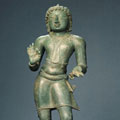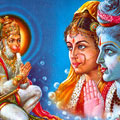|
|
 |
 |
| The Path of Devotion: Bhakti |
|
|
"Object of my thoughts!" she cries
"Shiva!" she cries
"Primal Being!" she cries
"First among the Gods!" she cries
O our father who dwells in Marukal
where the blue lily blooms in clusters,
is it right
to afflict this woman with longing?
By Campantar [Sambandar], 6th-7th century
Translated by Indira Viswanathan Peterson, Poems to Shiva: The Hymns of the Tamil Saint (Princeton Library, 1989), p. 248.
Bhakti, or devotion, refers to the act of sharing in the full and ecstatic worship of God: the very root of the word bhakti is bhaj, meaning "to share or apportion." Shiva, Vishnu, and the Goddess are the central focus of devotion in Hinduism and the major deities of the Puranas, genealogical and historical texts composed from the first millennium to the modern period, and are worshiped alongside the local and regional deities revered throughout the Hindu world. With its focus on personal experience, bhakti gives voice to alternative practices and practitioners, such as women and those of lower caste. At the same time, it has deeply influenced many temple-based and high-caste practices, as well as Buddhist, Jain, and other religious traditions.
Bhakti insists upon the immediate, direct apprehension of God, whether contained within a form (such as an image) or existing in unknowable formlessness. The language of intimate relationships is key: poets sing of God as a devoted lover, guardian, parent, or child. Bhakti as a social and religious movement began, in Hindu circles, in the south of India, among the saints who sang of their love for God in Tamil -- a major regional language with an established classical literary canon -- rather than in Sanskrit, the language associated with Brahmins and temple-based orthodoxy. These early saints included the Alvars, devoted to Vishnu, and the Nayanars, or "leaders," who were devoted to Shiva (Figures 1 and 2): traditionally, there were twelve Alvars and sixty-three Nayanars. Some of these saints were men from the lower castes or women -- segments of society generally excluded from religious power -- and their poetry gave voice to a new form of valid religiosity. Many of the famous temples of the south were founded at sites related to the lives and works of these saints, and their poetry came to be considered a form of revelation equivalent to the Vedas, the early revelatory texts that form the basis for later developments in Hinduism. Bhakti literature is known for being in the vernacular -- poets sang in the language of their peers, recognizing God in their midst -- but devotionalism can already be found in Sanskrit texts at the beginning of the Common Era, most notably in the Bhagavad Gita, a part of the epic the Mahabharata, which asserts the validity of devotion as an effective means of achieving oneness with the ultimate. The monkey-God Hanuman is portrayed as a model devotee in the epic Ramayana, versions of which exist in both Sanskrit and vernacular languages (Figure 3). His unswerving devotion to his Lord, Rama, is the subject of many modern poster prints.
Bhakti is a pan-Indian phenomenon, with significant regional variations. For example, the Lingayats (or Virashaivas), devotees of Shiva based in Karnataka in the west during the 12th century, practiced a more radical form of the devotionalism found in the south. The Tamil saints described above sang of their direct access to God with an emphasis on the temple and the ritual system associated with it; for example, the poems of Sambandar invariably mention a particular temple and location associated with Shiva. The Lingayats of Karnataka, on the other hand, challenged this system, and asserted that God was only accessible outside formal and hierarchical religious contexts. By the 17th century, bhakti had transformed the religious landscape of the north, as exemplified by the Rajasthani poet-saint Mirabai, a devotee of Krishna, and by Kabir, who lashed out against superficial religiosity on all levels and sang of an unknowable, formless God.
< previous next >
Top |
|
 |
 |
| Click for details |
 |
 |
 |
Fig. 1
|
 |
 |
 |
Fig. 2
|
 |
 |
 |
Fig. 3
|
 |
|
 |


